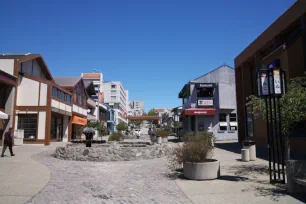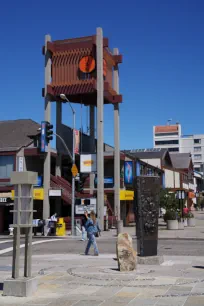Home to about twelve thousand Japanese Americans, San Francisco’s Japantown presents visitors with an opportunity to enjoy Japanese culture, shops, and restaurants. The area’s main sight is the Peace Pagoda.
History of the Neighborhood


The Japanese have been coming to San Francisco and the surrounding Bay Area since the 1860s. While they first lived in Chinatown and other areas south of Market Street, the fire caused by the great earthquake of 1906 forced them from those areas and prompted them to find homes in a neighborhood known as the Western Addition, untouched by the fire, located west of Union Square.
As the Japanese moved to the area, they began establishing not only homesteads but also stores, eateries and temples. The neighborhood soon became known as Nihonmachi or Japantown (sometimes also called J-Town).
The start of World War II resulted in the internment of most Japanese Americans on the West Coast of the U.S., so much of Japantown was empty during the war years. After WWII ended, many Japanese returned to the neighborhood to resume their lives. As a matter of fact, the overcrowding in the area after the war resulted in redevelopment of the neighborhood and the awarding of an urban renewal grant that allowed for new buildings to be constructed.


In 1968, the 3-square-block Japan Center (originally the Japanese Cultural and Trade Center) was completed. The center includes a deluxe hotel and two malls – the Kintetsu and Miyako. Another mall, the Osaka Way, was completed in 1976. Japan Center was part of an ambitious project that unfortunately also included the construction of the Geary Expressway, which cuts off the neighborhood to the south.
What’s There?
JapanTown has large variety of stores, from those offering traditional Japanese fare to fancy boutiques and well-priced electronics vendors. Also located there are a handful of art galleries and a subsidiary of the largest bookstore chain in Japan, Kinokuniya Bookstore, which sells books written in both English and Japanese.
Restaurants – mostly Japanese – are plentiful. You’ll find national chains like Benihana as well as small “mom and pop” operations that offer some of the best Japanese food on the West Coast. There are also a number of churches and temples in Japantown such as the Sokoji-Soto Temple, a Buddhist temple built in 1984.
Peace Pagoda and Japanese Gate
Don’t miss a visit to the Peace Center and five-story, 100-ft-tall (30 m.) Pagoda, the centerpiece of Japantown and a good photo opportunity. The pagoda, designed by Japanese architect Yoshiro Taniguchi, was given to Japantown by the people of Osaka, San Francisco’s sister city in Japan. This affiliation led to yet another nickname for Japantown: Little Osaka.
Another landmark in Japantown is a Japanese mountain temple gate, built in 1976 as the symbolic entrance to the Buchanan Mall. The Mall, which is now known as the Osaka Way, is a picturesque pedestrian street paved with cobblestones and bordered by houses built in Japanese style.

